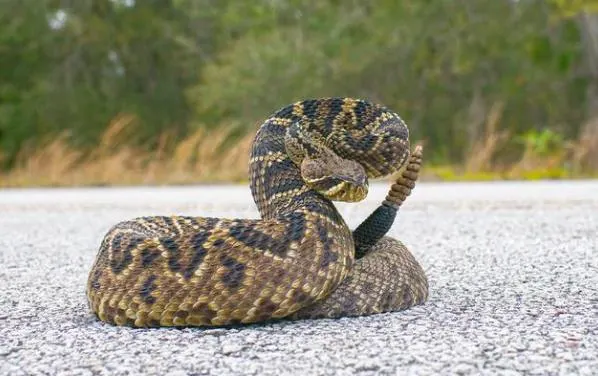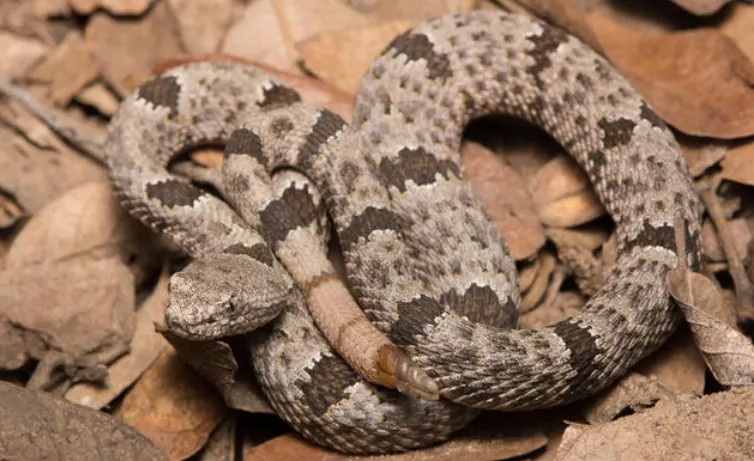Rattlesnakes, these diverse American reptiles, come in 32 species and about 83 subspecies. Split into the Crotalus and Sistrurus genera, their variety arises from living in different habitats, sparking speciation. In this chat, let’s dive into the natural story of some pretty interesting North American rattlesnakes.
Now, let’s spill the tea on 7 cool North American rattlers.
Table of Contents
1. Eastern Diamondback

Meet the eastern diamondback (C. adamateus), the second-longest and heaviest rattlesnake in the U.S., with some reports of stretching up to 8 feet. It’s got this rad dark diamond pattern on its back, perfect for blending into its southeastern U.S. coastal plain digs. These snakes roll with gopher tortoises, crashing in their burrows for hibernation, birthing, and dodging predators. They also chill in rotting wood stumps, connected by a root system network. Dining on small mammals or quail, adult eastern diamondbacks are basically snake royalty, but watch out for bobcats, raptors, feral pigs, or other snakes if you’re a young one.
2. Timber/Canebrake Rattlesnakes

Timber rattlesnakes, known for their chill vibes and laid-back moves, used to have two subspecies—timber rattlesnake (Crotalus horridus horridus) and canebrake (C. h. atricaudatus). Later, it turned out they were practically twins genetically. But some folks still argue for treating them as separate species, pointing to their looks.
Both are big, chunky rattlesnakes with dark chevrons and light-edged scales on their backs. These cool customers usually won’t bother rattling unless you really bug them. Their stealthy style lets them disappear in leaves or grass, just sticking their heads out.
In the eastern U.S., timber rattlers like hanging out in hilly spots with forests and meadows. Canebrakes, on the other hand, dig wetter places near water and swamps in hardwood forests, especially down south where tall grasses rule. Sadly, both crews are facing tough times—habitat loss, human stuff, farming, catching them for fun, and worse, killing them for no good reason. Plus, there’s this new snake sickness (Ophidiomyces ophiodiicola) causing extra problems for timber rattlers. Keeping an eye on these challenges is key to making sure these laid-back reptiles stick around.
3. Mojave Rattlesnake

Getting bit by a Mojave rattlesnake (C. scutulatus) is no joke—it’s a serious medical emergency. Often mistaken for the western diamondback, these snakes share territories and rock that classic diamond pattern on their backs, from brownish to muted green.
To tell them apart, just check out the tail bands and facial stripes. Mojave rattlers rock two to eight black-and-white bands near the rattle, with the top one being black and usually slimmer. Their facial stripes run from the eye to the mouth scales, starting at the eye and extending past the jaw.
If a Mojave rattlesnake bites, you’re in for a rough ride. Found from California to Texas, these snakes have different venom mixes depending on where they live. Some pack the “Mojave toxin,” a potent neurotoxin (Type A), while others carry a mean hemotoxic venom (Type B). In central and southern Arizona, there are even individuals with both venom types, creating a dangerous mix of hemotoxic and neurotoxic effects that can be downright life-threatening.
4. Western Diamondback

Say hello to the jack-of-all-trades in the rattlesnake crew—the western diamondback rattlesnakes (C. atrox). These guys, usually hitting 3.5 to 4.5 feet, rock a cool diamond pattern on their backs, though it’s a tad lighter than their eastern buddies. Their color game goes from light tan to red, matching their wide-ranging homes, from flat, dry spots to rocky mountain havens.
With four to six slick black-and-white bands before their tail gets all rattly, these rattlers know how to put on a show. When things get heated, they bust out the classic rattling and coil up, ready for action. Fun fact: These snakes hold the title for biting more folks than any other U.S. rattlesnake.
But life isn’t all sunshine and rainbows for our diamondback friends. From dodging predators like birds, snakes, and roadrunners during their early years to dealing with humans messing up their habitats, these snakes have it tough. They snatch up around 125,000 of these snakes every year for events that claim to be educational but are more like a setback for rattlesnake conservation.
5. Pygmy Rattlesnakes

Meet the pygmy rattlesnakes (Sistrurus miliarius miliarius, S. m. barbouri, S. m. streckeri), the colorful characters of the southeastern U.S. all the way to eastern Texas. These little guys know how to blend in, making homes in pinewoods, hardwoods, and even near marshes and river bottoms. You’ll spot them hanging out among logs, rocks, and even junk piles, soaking up the good stuff.
Now, about their style—these pygmy rattlers don’t hold back. Some show off vibrant orange to red shades, while others go for the mysterious dark, almost black look. It’s a diverse crowd, living their best lives in a variety of colors and patterns.
6. Banded Rock Rattlesnake

Meet the banded rock rattlesnake (C. lepidus klauberi), the cool cat of the rattlesnake world, rarely stretching beyond a humble 2 feet. These guys keep it exclusive, with a hangout along the Mexican border in Texas, New Mexico, and Arizona, and a bit more widespread in the Mexican mountains.
Being masters of disguise, you won’t easily spot these cryptic rattlers—they’re small, speedy, and blend in like pros. They call elevations of 5,000 to 8,000 feet home, chilling out in open rockslides, rocky nooks, and pine-oak and conifer forest spots.
7. Twin-Spotted Rattlesnake

Meet the tiny dynamo of the rattlesnake crew—the twin-spotted rattlesnake (C. pricei pricei). These fellas hold the record for being the smallest rattlesnake in the U.S., often rocking a rugged appearance in the wild. The biggest star on the block measured in at a modest 26 inches. You’ll catch them chilling in the Chiricahua, Huachuca, Santa Rita, and Pinaleno mountains of southeast Arizona, slinking around rock slides and hardwood and conifer forests at elevations above 6,000 feet. Don’t worry too much, though—human encounters with their venom are rare, with no known fatalities on the record.
Tips for Keeping Rattlesnakes
Thinking of taking on rattlesnake duty? Well, only the seasoned snake whisperers need apply. Keep direct contact to a minimum, and always have the right tools on hand. Before diving into rattlesnake ownership, know your snake(s)’ venom type—it can vary among species.
If you’re eager to be a rattlesnake pro, get some hands-on experience at a zoo or connect with someone who’s a legal rattlesnake guru. These snakes can be a bit unpredictable, but with proper training, you’ll learn their moves and be ready for any potential strikes.
Pro tip: Keep your interactions brief, only getting up close and personal for feeding and cleaning. Tools of the trade? Hooks and tongs. And when you’re dealing with venomous reptiles, like rattlesnakes, it’s safer to have a buddy around. Never open a cage by hand—always use a tool.
Need to move a rattlesnake? Grab a large trash can or a 5-gallon bucket (depending on the size) with a secure lid. ‘Shift boxes’ can help too, though they’re a bit trickier with pit vipers. These methods make cleaning enclosures a breeze. And for feeding, long hemostats or tongs are your go-to tools.
Remember, keeping rattlesnakes is no walk in the park—it comes with some serious risks. Every time you open that enclosure, you’re playing the rattlesnake lottery, so stay sharp!
Handling Rattlesnake Bites
So, rattlesnake bites are a serious business, with 7,000 to 8,000 happening annually in the US and Canada. Most occur when people try to mess with these snakes. If you think you’ve been bitten, don’t play games—get medical help ASAP.
Any rattlesnake bite can be pretty serious. The person bitten needs to be taken to the hospital pronto by paramedics. Waiting around is a terrible idea. Even if you’re keeping rattlesnakes against the rules (not smart, by the way), prioritize your life over worrying about your snakes getting taken away.
For first aid, rush to the emergency room, lose any constricting bling, and keep the bitten limb lower than the heart.
Now, there are loads of myths about treating venomous snake bites. Here’s the real deal: no tourniquets, no trying to suck out the venom, and definitely no DIY cutting and sucking. Venom extractors? Yeah, not recommended.
The severity of a bite depends on a bunch of factors, like how fast you get treatment, the snake species, how much venom you got, and your age, size, and overall health. You don’t even need fang penetration for envenomation—any break in your skin can let the venom do its thing.
- Enchi Ball Python: A Unique and Stunning Morph of Python regius - March 27, 2025
- Emerald Tree Monitor: The Enigmatic Green Guardian of the Rainforest - March 26, 2025
- The Egyptian Cobra (Naja haje): A Fascinating Serpent - March 25, 2025
